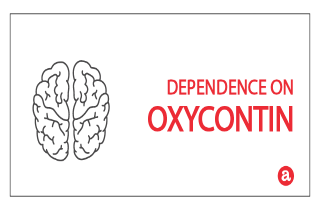OxyContin is a brand-named slow release version of the painkiller oxycodone. OxyContin uses and side effects make it a Schedule II medication, which means that you have a high chance of developing dependency to OxyContin (even when taken as prescribed). In fact, anyone can develop oxycodone dependency or even experience OxyContin tolerance.
But what exactly is OxyContin dependence? What are clinical signs of dependence and how do they differ from addiction? And if you are dependent on oxycodone, how to quit taking OxyContin without negative withdrawal symptoms? Here, we answer these questions and more. If you still have questions, please ask them in the comments section at the end.
OxyContin dependence time: How long to be dependent on OxyContin?
While OxyContin is regularly prescribed to treat pain, oxycodone effects the central nervous system receptors. While oxycodone blocks responses of pain to the brain, it also becomes assimilated into the body system over time. The longer you take OxyContin, the more normalized it becomes in your body and brain. Even if you are using OxyContin as prescribed and monitored by a doctor your body can still develop a dependency. This is the phenomenon of dependence: daily doses of OxyContin are then NEEDED for normal body function.
How quickly does it take to be dependent on OxyContin?
Dependence on OxyContin can develop as quickly as a couple of weeks or a month of taking OxyContin daily. Abusing OxyContin by snorting, smoking, injecting or taking higher doses to get high will speed your development of dependence to the drug. If you have become dependent on OxyContin, it is important to decrease dependence over time. This may take while because the recommended procedure is to taper doses of OxyContin slowly over several weeks to minimize the severity of withdrawal symptoms and to allow your body to readapt.
Dependence on OxyContin symptoms
Key symptoms of OxyContin dependence may include one or all of the following:
1. Increased tolerance to oxycodone (needing more oxycodone to feel therapeutic effects)
2. Needing to take OxyContin in order to prevent withdrawal symptoms.
3. The presence of withdrawal symptoms when you stop taking OxyContin.
Keep in mind that increased tolerance to OxyContin may just mean that you need to take more OxyContin for pain relief. Tolerance is not necessarily related to dependence. However, tolerance to OxyContin can be the first red flag to indicate increased dependence on OxyContin.
OxyContin dependence vs addiction
Dependence on OxyContin and addiction to OxyContin can exist in tandem with one another. For the most part, OxyContin addicts are usually physically dependent on oxycodone. However, dependence alone doesn’t mean you’re addicted.
Basically, dependence is a process that occurs in the body. Over time, OxyContin integrates in to the overall normal functioning of the body. The body adapts and incorporates oxycodone as just another chemical in the body. When you remove the drug from the system, your body reacts and you experience withdrawal symptoms. This process can be both painful and dangerous. On the other hand, addiction is characterised by the presence of psychological behaviors and patterns of thought (such as needing the drug to cope with the daily stress of life). You may constantly be thinking about the drug or do negative things to acquire it. Maybe you’re doctor shopping. Those are just a few examples which point to an addiction to OxyContin. In sum, dependence happens to the body; addiction occurs in the mind.
Physical dependence on OxyContin
Dependence is the physical and bodily need to take OxyContin in order to function normally. Over time, your body begins to adapt to the presence of OxyContin. It becomes part of the normal body/brain functions and processing. So, when you stop taking OxyContin, the body needs time to re-regulate body chemistry and triggers withdrawal symptoms. So if you experience withdrawal symptoms from OxyContin, this is a clear sign that you’ve become physically dependent on OxyContin.
Psychological dependence on OxyContin
When you experience psychological dependence on OxyContin, this could mean you’ve become addicted to the drug. Psychological signs of dependence to look out for are:
- Craving OxyContin
- Doctor shopping in order to get OxyContin
- Obsessive thinking about Oxycontin (how to get, use, and have it)
- Taking OxyContin to escape reality
- You have a compulsive need to take OxyContin
If you notice the presence of psychological dependence on OxyContin, stopping oxycodone suddenly or tapering may not be enough. You may also need the help and support of a behavior specialist who understands dependency and addiction. Counselors, doctors, psychologists or psychiatrists can offer you the support and tools you need to no longer feel like you need OxyContin to get through the day.
OxyContin dependence withdrawal
OxyContin dependence withdrawal is like getting a nasty cold and flu. While your central nervous system responses were slowed while on the medication, everything now seems it’s in overdrive. Your body must go through this period of withdrawal to regain true normalcy and function without the presence of OxyContin in the body system. Symptoms of withdrawal to look out for include:
- accelerated breathing
- anxiety
- depression
- fast heart beat
- joint pain and aches
- loss of appetite
- nausea/vomiting
- restlessness
- runny nose
- sleep disturbances
- watering eyes
- yawning
If you are experiencing the effects of withdrawal there are medication and home remedies that can help. Also, you can use a standard opioid tapering method to deal with the withdrawal symptoms you are experiencing.
OxyContin dependence questions
Do you still have questions about OxyContin dependence and addiction? We invite you to leave us your questions about dependence on OxyContin below. We welcome all questions and try to answer each one personally and promptly.









Related Posts